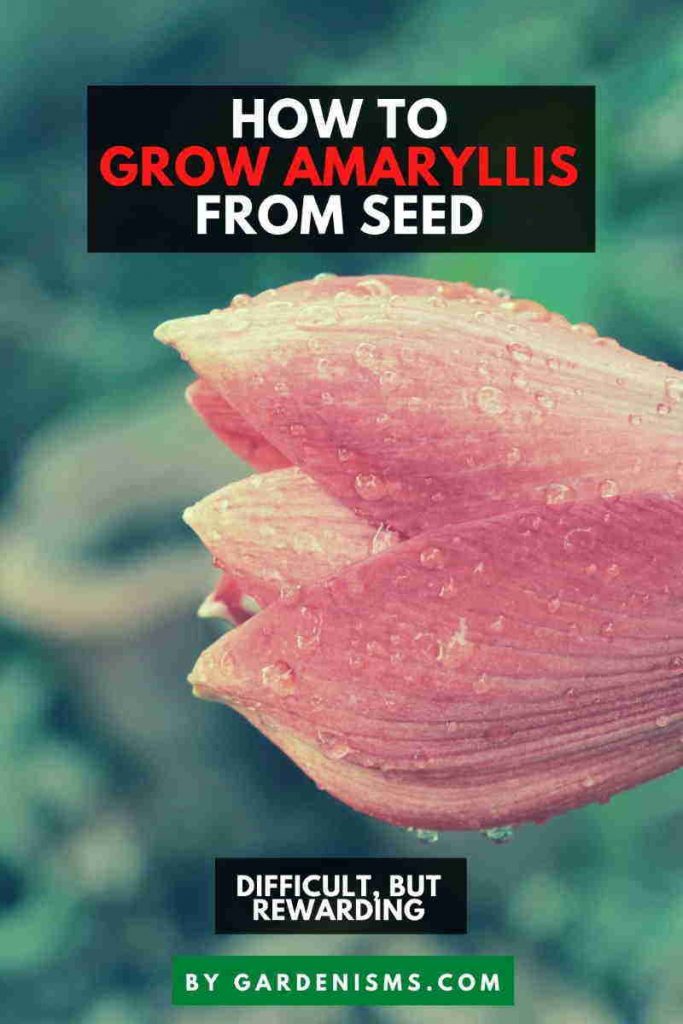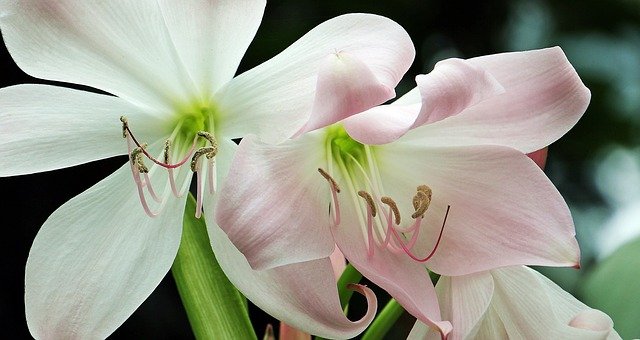So, you want to grow amaryllis from seed.
Did you read about how challenging it can be? Or is your calling to be challenged?
You’re in for quite the ride, as this will take many years and will test your patience. This is NOT for the impatient type!

But do it right and you’ll find it rewarding! Especially when you start from seed.
If you give it some time and be patient, it’ll show up as gorgeous, large blooms that’ll bring the neighbors over.
While it’s not exactly good for beginners, it can be done with some TLC!
Let’s dive in and find out what it’s all about. Perhaps demystify WHY this plant is so hard to grow in the first place?
Guide Contents
Can you grow amaryllis from seed?
Amaryllis can be grown from seed or bulb, and both are equally as rewarding.
The benefit of growing this beauty from seed is that you can nurture it from the start and see it go from sprout to a flowering blossom.
Growing from seed also has that unpredictable nature of not knowing what kind of flower color you’re going to get. So that’s always pretty fun.
Things you should know about sowing from seed

Here are some things that are important to note before you go on a journey in your yard.
How long does it take amaryllis to grow from seed?
This is the most frequent question people ask about sowing amaryllis plants from seed.
It takes, on average, up to 5 years for it to flower.
Some varieties flower much quicker while others are slower. It also depends on your local conditions, such as hardiness zone, climate, and nutrient availability with plant competition.
Hybrid flowers
These plants are easy hybrids, which means they hybridize and will cross-pollinate amongst themselves.
So the seeds you collect in your garden from your amaryllis may result in phenotypes from both the original parent plants.
The F1 progeny probably has phenotypes exhibiting from both of the original plants.
Amaryllis seeds rarely resemble the original plants since they easily pollinate themselves. If you want a replica, you should grow from bulb or bulb offsets.
This will let you plant an entire garden full of the same plant which is good for people who want symmetry.
Seeds are difficult to find
Lastly, seeds for amaryllis are hard to find.
Sure, you can go online and buy them.
But finding a particular strain or cultivar is hard.
The best way other than getting something random online with a random hybrid is to get some from an experienced gardener.
This is the best way to ensure you’ll get what you want. If you don’t care about the color, then you’re in for a good time.
But whatever works in your hardiness zone from your local nursery or online. And let’s grow from seed!
Let’s cover the exact process of growing these gorgeous beauties from seed.
You can modify this accordingly to your specific cultivar or hardiness zone. But the general process is largely the same.
How to grow amaryllis from seed

Here are steps you need to know.
Collecting and harvesting amaryllis seed pods
Wait until the seed pod starts to break apart on its own. The pod will begin to split across the seams and crack open.
You can break it off the plant and then use a sharp knife to rip it apart. You’ll find the seeds inside the pod.
There are about 180 seeds on average, so a single seed pod will fill up your entire garden easily.
If not, then harvest another seed pod as they all tend to become “ready” at the same time.
The best time to harvest is when the pods turn yellow.
Don’t abandon the original plant upon harvesting the seeds. If you want it to produce for you, you should prune as needed.
The leaves will need to be trimmed. Move the original plant outdoors with the seed pods during the summer.
Use a plant food rated at 10-30-20 after harvesting.
When you slice the pod open, you’ll see 3 different sections. Each section has a ton of small seeds that you can use to plant.
These are amaryllis seeds that are ready to plant, though they probably have been hybridized with pollen from different plants, so they won’t be an exact clone of the original plant you harvest the seeds from.
To separate the seeds from the seed pod, grab a large plate or newspaper and wiggle the pod back and forth.
This will help loosen the seeds from the pod and the seeds will fall out by themselves into the plate.
The pods should be ready for collecting in about 4-6 weeks after the flowers have been pollinated.
Don’t harvest it before the plant is ripe. The pods will turn yellow after they’re read and there will be black seeds visible within the pods.
Do a quality check
Examine the hippeastrum seeds and remove any seeds that are damaged, dried out, or just don’t look like seeds.
This will improve your germination rate later on when you plant them. If you don’t know what to look for, the seeds should be mostly flat, black with random ridges running through them, and shaped like small teeth.
Just look at what the majority look like and go from there.
You’ll want to plant them immediately because the seeds don’t hold well. The pods feel like paper and you can rub them with your thumb to feel from seeds, though this doesn’t always work.
How to prepare the seeds
The seeds are pretty much ready to go.
All you need to do is to put them in a dark, cool area for a week or so.
Wrap them in some newspaper or paper towels. The point is to get the seeds free of any moisture and water so they dry out.
The seeds don’t store well and will mold quickly or become sterile, so you shouldn’t expect all of them to germinate.
You also need to work with them quickly so you have the best germination success.
You do NOT need to put them in the cold or your fridge before you sow them.
Amaryllis isn’t a plant that requires cold exposure for the seeds to sprout, unlike astilbe.
When you plant them, don’t cover the seeds completely. Keep the planting substrate wet, but not waterlogged.
Let the seeds dry for at least 7 days in a cool, dark area free from moisture. They can be kept in a sealed mason jar and put in your kitchen pantry.
You should aim for 7 days at max.
Don’t go over 7 as the most days you wait, the lesser chance of successful germination. The seeds generally don’t store well and aren’t hardy at all.
This is why they’re not easy to find in stores as the company would have to sell them right away.
And since most people plant amaryllis by the bulb, they hesitate to sell it. It’s just wasting their inventory and money.
Sowing the seeds

So your seeds are harvested, cleaned, and prepped. They’re ready to be planted now.
Depending on whether you want to sow your seeds using a planter or sowing directly into the soil, the process varies slightly. Read below for more details.
Using a planter
The seeds are ready to go!
Start by using a small container with at least an 8” diameter. Make sure there are drain holes at the bottom so the water will come easily.
Preventing water logging is important. This will reduce the chance of root rot or powdery mildew.
Add some high quality well-draining potting mix into the container. Supplement with perlite or sand to help improve the water drainage.
Add your seeds into the container, each 1” apart and ⅛” deep.
Water generously for the first time around to help establish water channels for drainage.
Seed starter
If you choose to plant the seeds in a flat, you can put one seed per square using the same planting depth and spacing. Water as needed.
Soil
And if you want to go all out and just start right in the soil, you can do so also.
This saves you the most time because you don’t have to transplant them later.
And you can plant as many as your garden can tolerate, rather than using individual planters. It’s the most efficient and cheapest method by far. And my favorite.
You can even just rub the paper-like seed pods and scatter the seeds. If you grow in the soil, plant them deep. 6” should be sufficient for proper root development.
Make sure you use high-quality soil. Add some vermiculite or perlite to help the drainage.
Plant the amaryllis seeds 1” deep and 6-8” apart so they have plenty of space to develop their roots and water generously for the first time. This will MI minimize competition for soil nutrients so they all develop nicely rather than being cramped.
Distribute the water evenly and keep it moist for two months until you see the sprouts of successful germination.
After that, reduce watering. Don’t let the water build up on the soil because this will make it waterlogged.
Depending on your specific cultivar and hardiness zone, your plant’s needs may vary.
However, these should be general guidelines that apply to this plant.
Propagating amaryllis seeds by floating
This method is a little more difficult but lets you know right away which seeds will germinate for sure before you plant them.
Growing amaryllis seeds in water is an efficient way to propagate them.
Floating the seeds filter out the good and bad seeds. It saves you from wasting a potting container or precious space in your garden for seeds that don’t grow.
You can effectively separate the nongerminating seeds from the germinating ones so you only dedicate your time and energy to the amaryllis seeds that are guaranteed to grow.
When they sprout, you know they’re ready for transfer into the sunlight.
Here’s how to set up a water float:
- Get a baking pan and fill it up with 2” of warm water. The width of the pan doesn’t matter.
- Sprinkle the seeds on the water surface and let them float.
- Remove the seeds that immediately sink to the bottom of the pan with a pair of tweezers.
- Use a piece of saran wrap and cover the baking pan. Wrap it around the edges to prevent evaporation.
- Place the pan somewhere warm, but not in direct sunlight.
- Top off the pan if needed. Keep the water level stable. You can use a piece of tape to easily gauge where the water level should be.
- Watch for the seeds to germinate. This will take up to 4 weeks. You’ll see some seeds sprout a root out which grows into a bulb.
- When the root is at least 0.5”, you can plant the seed in your pot or garden. The rest of the seeds that don’t germinate can be disposed of.
- Place the seed’s root into the soil. Use a well-draining potting mix. You can use a chopstick or fork to make holes. Only the root needs to be inserted into the soil.
- Use some soil to lightly cover the seed’s edges. Space each seed about 1” apart.
- Water generally for the first time.
See how that just saved you time? Now you’ll only be planting amaryllis seeds that will grow for sure.
Tips and tricks
Here are some general suggestions for the care of your seedlings.
Plant food
Amaryllis can benefit from some plant food, but less is more when it comes to these flowering blooms.
You can use all-purpose general plant food, but consider using half the dose or diluting it with water.
Whatever you do, don’t overdo the plant food. These plants are small and will be burned by overdosing fertilizer, so use as directed.
The amaryllis will look like tiny bits of grass and will take a few years before they even resemble amaryllis.
Use a water-soluble fertilizer rated at 20-20-20 NPK. Amaryllis do well with fish emulsion or liquefied kelp.
Sunlight
Keep the newborn seedlings out of direct sunlight in a warm location.
You can place them indoors if you’re growing in pots near a window with lots of indirect light.
If growing outdoors, you can create a microclimate and scatter any direct sunlight.
For those that have a greenhouse (I’m envious), it works perfectly for the seedlings.
Temperature
Amaryllis isn’t a cold-hardy plant.
Therefore, you should move them back to a sheltered location or indoors if the temperature drops below 50F. The seedlings don’t need a cold stratification period, but will after they develop a bulb.
The seeds do best around a south-facing window during the winter. Even your bathroom should be enough for lighting during this time.
A dry dormancy will help them grow after they become established.
The bulb will do best where the air is somewhat warm and the humidity is high, which they like.
Turning the seeds
If your plant grows sideways or lopsided, you need to adjust them by turning. Gently turn them so they grow properly.
Watering
You should water generously when you first plant them into the soil.
But subsequent waterings should be less. The soil should be nearly dry between each watering session, but not completely.
Don’t let the water build up and become waterlogged. Reduce further in the winter.
Transplanting
If you planted your seeds in a potting container or starter kit, you’ll have to transplant them later as they’ll likely outgrow their original home.
The roots eventually turn into full-sized bulbs (which you can use to propagate amaryllis).
So you’ll need to move them to a larger pot or the soil in your yard. This is why it’s beneficial to start from direct garden sowing because it saves you time later and doesn’t have any chance of transplant shock.
Transplant into 4” containers if you want to give some to friends. You can grab the bulbs at the point where the foliage comes out of the bulb and move it to a new container.
Then put a handful of potting mix around it.
Add some water and it’s ready to go. If you want to grow multiple amaryllises per container, you can group 4-5 in a 4” pot.
Be sure to water well until the potting mix is completely moistened.
If you want to transplant a single plant, wait until the bulbs are about 0.5” wide. Move them into gallon size containers and use a good potting mix.
The foliage will stand upright and start growing quickly. Give them a few hours of sun daily but keep them out of direct sun for extended periods.
Partial sunlight works best for this plant. Yes sir.
Regardless, amaryllis can be transplanted into a larger area when the green blades are at least 4” in length.
You don’t have to move them right away, but waiting and delaying can result in blooms that are less than voluminous.
Be patient
Amaryllis is a slow grower and starting from seed is a test of patience. The bulbs will take many years to grow before any flowers show.
The plant doesn’t go dormant in the winter, but signs of plant growth will seem nonexistent.
This applies to the first few years. In the later years, the plant will enter dormancy, which means that you should have the flowers to show up next season.
Give your plant regular plant food, scheduled watering, and protect it during the winter if necessary.
You’ll be rewarded with those signature flowers within 3-5 years.
Further reading
Here are some references you may find helpful:
- Is my amaryllis pregnant? What do I do? : whatsthisplant – Reddit
- Amaryllis – Easy to Grow, Even from Seed – Georgia.Gov
Planting amaryllis from seed is a process

You should have everything you need to know about planting, harvesting, and growing amaryllis straight from seed.
These plants are a staple to any garden and will add a splash of color to your yard.
Perfect for complimentary plants, border plants, or something just to make your garden that much prettier.
What do you think? Will you be taking on the challenging (yet rewarding) process of starting from seed?
Let us know your thoughts in the comments section!

I took interest into microflora and microgreens before it became mainstream. The idea of growing an entire ecosystem on a tiny scale simply was astounding. That’s where I discovered that I actually like raising plants and wasn’t as much of a black thumb as I thought. Now, I’m relaying what I’ve learned to others who are getting into the hobby in a way that anyone can understand.
Love any plant grow from seeds and now I love to grow this beautiful flower thank you for sharing this article
Six inches seems a little deep to plant a seed.